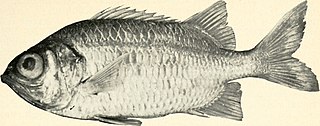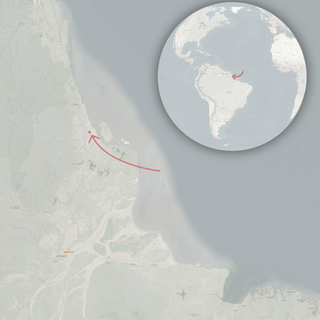
The mottled eel, also known as the African mottled eel, the Indian longfin eel, the Indian mottled eel, the long-finned eel or the river eel, is a demersal, catadromous eel in the family Anguillidae. It was described by John McClelland in 1844. It is a tropical, freshwater eel which is known from East Africa, Bangladesh, Andaman Islands, Mozambique, Malawi, Sri Lanka, Sumatra, and Indonesia and recently from Madagascar. The eels spend most of their lives in freshwater at a depth range of 3–10 metres, but migrate to the Indian Ocean to breed. Males can reach a maximum total length of 121 centimetres and a maximum weight of 7,000 grams. The eels feed primarily off of benthic crustaceans, mollusks, finfish and worms.

The masked hamlet is a species of marine ray-finned fish, a sea bass from the subfamily Serraninae which is part of the family Serranidae, which also includes the groupers and anthias. This species is found in the western Atlantic Ocean in the Caribbean Sea and has been recorded from the coast of Central America from Quintana Roo in Mexico to Bocas del Toro in Panama and from Jamaica to Puerto Rico, as well as in the Turks and Caicos and the Cayman Islands. Its specific name refers to Providencia Island, Colombia where the type was collected. It was also recorded from other islands in the Archipelago of San Andrés, Providencia and Santa Catalina. They are a unique species in the Hypoplectrus genus, defined by their unique color morph. Their behavior is largely similar to that of other hamlets, especially in their diet and egg-trading spawning patterns.
Naevochromis chrysogaster is a species of cichlid endemic to Lake Malawi where it prefers areas with rocky substrates. This species has a specialized diet, feeding on the fry and larvae of other cichlids. It reaches a total length of 17.9 cm (7.0 in). This species is also seen in the aquarium trade and sometimes goes by the name Haplochromis Jack Dempsey. It is currently the only known member of the genus Naevochromis.
Arthurs galaxias is a species of fish in the family Galaxiidae. It is endemic to Tasmania in Australia.
Taeniolethrinops laticeps is a species of cichlid endemic to Lake Malawi where it occurs over sandy substrates. This species can reach a length of 30 centimetres (12 in) TL. it was discovered by Ethelwynn Trewavas.
Lupinoblennius paivai, Paiva's blenny, is a species of combtooth blenny endemic to a small area Brazil from Bahia to Santa Catarina where its habitat is the tidal reaches of coastal streams and small rivers. This species can grow to a length of 5.1 centimetres (2.0 in) SL. The specific name honours the Brazilian oceanographer João de Paiva Carvalho (1903-1961) of the Instituto Oceanográfico da Universidade de São Paulo in recognition of his cooperation with Pinto.
Xenocypris yunnanensis, the Kunming nase, is a species of ray-finned fish in the genus Xenocypris. It is endemic to Lake Dianchi in Yunnan Province, China. The species started to decline in the 1970s and has not been caught in the lake after two specimens were collected in 1985; it may be extinct. Its demise is likely due to introduced fish species, grass carp. It was also impacted by over-fishing and pollution. They grow to a maximum length of 23 cm. They are dark grayish with a silvery white belly, gray dorsal fin, reddish anal fin and orange red caudal fin. They have a rounded belly, blunt snout, eyes on the lateral of their heads, small and transverse mouth.
Gnathophis longicauda, the little conger, little conger eel or silver conger, is an eel in the family Congridae. It was described by Edward Pierson Ramsay and James Douglas Ogilby in 1888, originally under the genus Congromuraena. It is a marine, temperate water-dwelling eel which is endemic to Australia, in the Indo-West Pacific. It dwells at a depth range of 2–99 metres, and inhabits the continental shelf and slope.

Arapaima leptosoma is a species of freshwater fish endemic to Brazil. It is a member of the arapaimas, a genus of air-breathing fish that contains some of the world's largest freshwater fish. Like other members of the genus Arapaima, this fish can breathe air. It is known only from the confluence of the Solimões and Purus Rivers in Amazonas, Brazil, although due to the lack of obvious geographic barriers, it likely has a larger range.
Ophichthys desilvai is a commercially important, air-breathing species of fish in the family Synbranchidae. It is endemic to Sri Lanka and is the only endemic synbranchid from there.
The pinkeye mullet, also known simply as pinkeye, or freshwater mullet, Richmond mullet, or river mullet, is a species of ray-finned fish from the grey mullet family Mugilidae and the only species in the genus Trachystoma. It is endemic to northeastern Australia where it occurs from the Burnett River in Queensland to the Clyde River in New South Wales. It is a subtropical species which is found in deep, slow flowing sections of rivers as well as in estuaries although it moves into coastal seas to spawn. It feeds mainly on algae and plant material, as well as detritus and benthic invertebrates.
Paragalaxias eleotroides also known as the is a genus of freshwater fish of the family Galaxiidae, endemic to Tasmania, Australia.
The Malabar swamp eel is a species of troglobitic swamp eel endemic to subterranean springs in Kottayam in the Indian state of Kerala.
Batasio travancoria, the Travancore batasio, is a species of freshwater fish endemic to southern Kerala. It was described from a tributary of Pamba River in Kerala state of India, known as Peruthenaruvi. The species is dependent on high habitat quality and does not tolerate organic wastes in the water. It is classified as a vulnerable species by the IUCN.

Plectrypops lima, the shy soldier, is a species of soldierfish from the genus Plectrypops. It can be found in the Indo-Pacific region from East Africa to Chile, north to Japan and the Ogasawara Islands. It is an uncommon inhabitant of reefs. During the day, it hides in deep crevices and comes out at night. It is solitary and cryptic. It feeds on small crustaceans, crustacean larvae and small fishes.
Myripristis formosa is a species of soldierfish belonging to the genus Myripristis. It is endemic to Taiwan in the North-west Pacific Ocean. It is named after the Republic of Formosa, a short-lived republic that existed on Taiwan. It is demersal with a depth range of 15m to 30m.

Myripristis gildi, also known as the Clipperton cardinal soldierfish, is a species of soldierfish belonging to the genus Myripristis. First described in 1965 by Greenfield, it is endemic to Clipperton Island in the Eastern Pacific Ocean. Its total length reaches at least 21.4cm.

Arapaima mapae is a species of freshwater fish endemic to Brazil, where it is known only from Lago do Amapá in Amapá State.

The swordtail platyfish is a species of ray-finned fish within the family Poeciliidae. The species is endemic to the Soto la Marina River basin in Tamaulipas and Nuevo Leon. It lives in springs, streams, arroyos, ditches, marshes, and ponds in slow-flowing clear to muddy waters, often over mud, clay, gravel, and rock where vegetation is typically abundant. Males grow 3 centimeters in length whereas females grow 4 centimeters in length, however both sexes can reach 1 centimeter over their usual length. Gestation is usually 24 to 35 days, where around 20 to 50 young are born.







